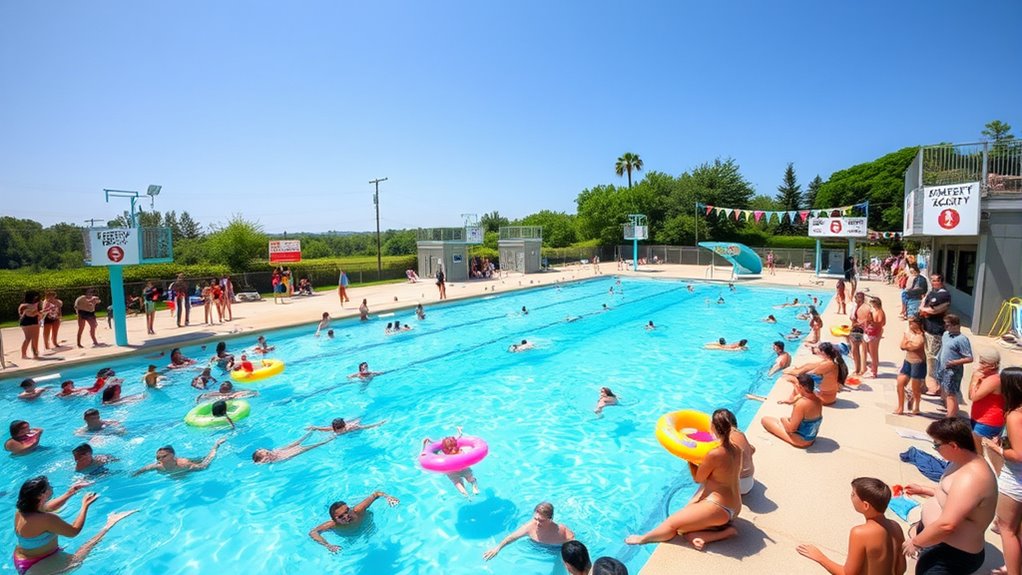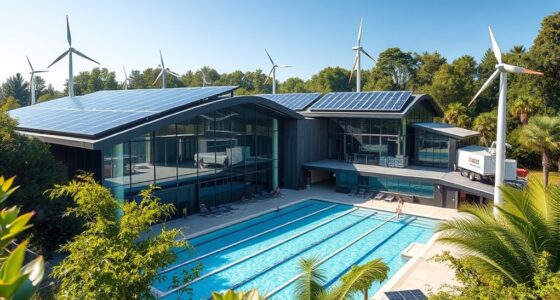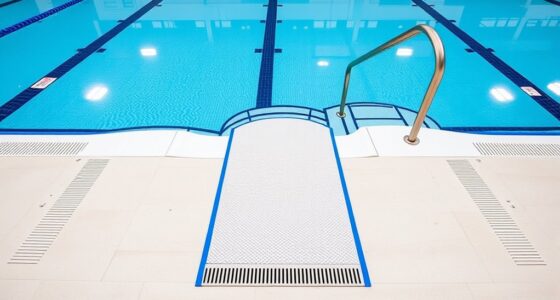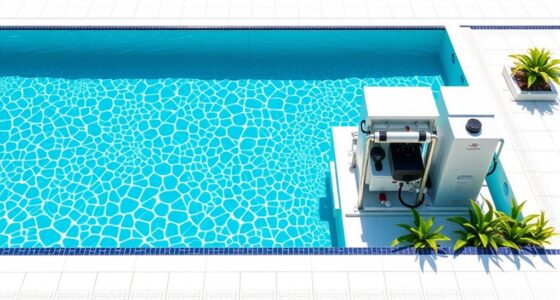To manage pool capacity and crowd control effectively, set clear limits and display visible signage at entry points. Use real-time monitoring systems and enforce capacity restrictions to prevent overcrowding. Communicate actively with visitors and consider scheduling activities or staggering arrivals to spread out usage. Proper staff training ensures quick response to overcrowding and safety issues. Maintaining water quality and clear signage helps improve safety and visitor experience. Keep exploring to discover more ways to create a safe, enjoyable pool environment.
Key Takeaways
- Implement clear capacity limits with visible signage and enforce them through trained staff.
- Use real-time monitoring systems to track occupancy levels and alert staff of overcrowding.
- Schedule activities and stagger arrivals to distribute pool usage evenly throughout the day.
- Communicate capacity restrictions proactively to visitors via signage and staff interactions.
- Ensure staff are well-trained in crowd management, emergency response, and effective communication strategies.

Are you struggling to keep your pool operations smooth during peak times? Managing pool capacity can be a real challenge, especially when crowds swell unexpectedly. To guarantee everyone stays safe and the experience remains enjoyable, you need a clear strategy for crowd control. One of the first steps is to rely on well-trained staff, starting with thorough lifeguard training. Proper lifeguard training equips your team with the skills to quickly identify overcrowding issues, enforce capacity limits, and handle emergencies efficiently. Well-trained lifeguards can monitor the pool area diligently, stepping in to prevent overcrowding before it becomes a safety concern. Alongside this, implementing water quality monitoring becomes essential. When the water quality dips due to increased usage, it can lead to health risks and dissatisfaction among swimmers. Regular water testing allows you to catch potential problems early, maintaining a safe and inviting environment. It also helps you enforce capacity limits by providing data that can justify restricting access during busy times, thereby preventing overcrowding and ensuring water remains clean and safe for all users. Additionally, understanding water quality monitoring can help you identify when the pool environment is compromised, further supporting crowd management efforts. To effectively manage capacity, consider setting clear limits and communicating them visibly at entry points. Use signage and staff to remind swimmers of the maximum occupancy, especially during peak hours. Incorporate real-time monitoring systems if possible. These systems can track the number of people in the pool and alert staff when capacity approaches or exceeds safe levels. When limits are reached, implement a waitlist or reservation system to control flow and avoid chaos at the entrance. This way, you can stagger arrivals and ensure the pool isn’t overwhelmed. Additionally, schedule activities and lap swim times to distribute usage more evenly throughout the day, reducing peak pressure. Educate your staff on crowd management techniques, emphasizing the importance of proactive communication and quick response to overcrowding signs.
Frequently Asked Questions
How Are Pool Capacity Limits Determined?
Pool capacity limits are determined through pool capacity estimation, which considers the size of the pool, available space, and safety compliance standards. You need to evaluate how many swimmers can safely fit without overcrowding, ensuring clear access to exits and safety equipment. By complying with local regulations and safety standards, you can set appropriate limits that protect swimmers and promote a safe, enjoyable environment.
What Technologies Are Used for Crowd Monitoring?
You might imagine a control room where video analytics and sensor integration work seamlessly. These technologies constantly monitor crowd levels, using cameras and sensors to track the number of swimmers in real-time. Video analytics analyze footage to count people accurately, while sensors detect movement and occupancy. Together, they provide instant data, helping staff manage pool capacity effectively and make certain of a safe, enjoyable environment for everyone.
How Do Staff Enforce Capacity Restrictions Effectively?
You enforce capacity restrictions effectively by providing thorough staff training on crowd management protocols. Use clear communication strategies, such as signs and verbal cues, to inform swimmers about limits. Monitor crowd levels constantly, and be ready to step in politely but firmly when capacity is reached. Staying alert and consistent helps prevent overcrowding, ensuring a safe and enjoyable environment for everyone.
What Are the Legal Requirements for Pool Capacity Signage?
You must guarantee your pool capacity signage meets local compliance standards, which typically specify size, wording, and visibility. Signage design should be clear, concise, and easy to read from a distance. Check with your local health or safety authority for specific requirements. By following these compliance standards, you help keep swimmers safe and ensure your pool operates within legal limits, avoiding penalties or liability issues.
How Is Capacity Adjusted During Special Events or Emergencies?
During special events or emergencies, you typically increase safety by implementing emergency protocols and reallocating capacity. Studies show that pools with flexible capacity plans handle crowd surges 30% more efficiently. You should immediately assess the situation, communicate clearly with staff, and adjust capacity limits accordingly. By reallocating space and following emergency protocols, you guarantee everyone’s safety while maintaining compliance with regulations. Always stay prepared to adapt quickly in these situations.
Conclusion
By effectively managing pool capacity and implementing crowd control measures, you guarantee a safer, more enjoyable experience for everyone. Remember, during peak times, overcrowding can increase the risk of accidents—did you know that nearly 30% of drowning incidents happen in crowded pools? Staying vigilant and enforcing capacity limits helps prevent such tragedies. With thoughtful planning, you create a fun, safe environment where all swimmers can relax and enjoy the water responsibly.









